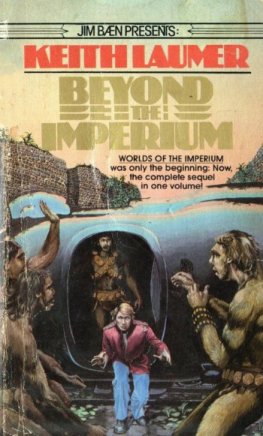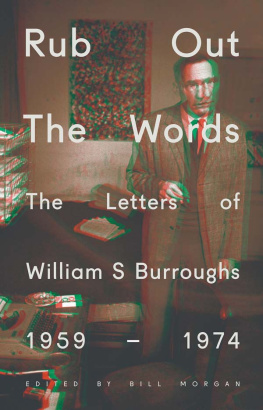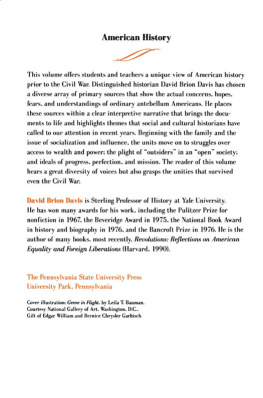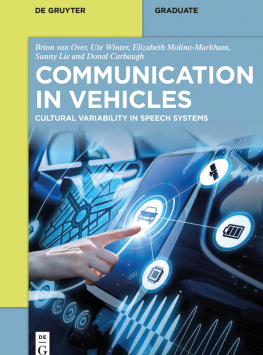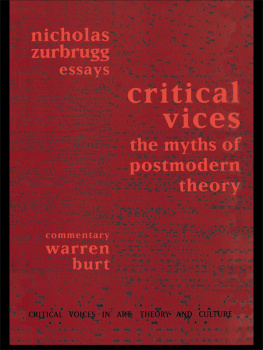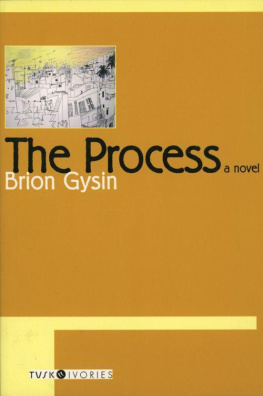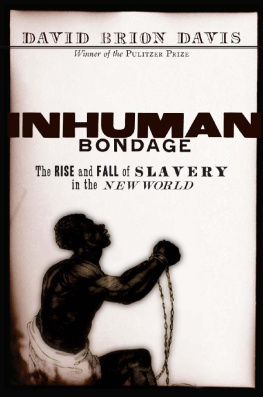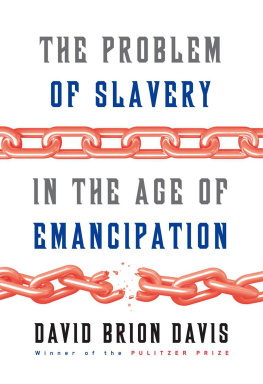
Back in No Time

| Back in No Time The Brion Gysin Reader Edited by Jason Weiss Wesleyan University Press Middletown, Connecticut |
Wesleyan University Press, Middletown CT 06459
www.wesleyan.edu/wespress
Introduction and notes copyright 2001 by Jason Weiss. All writings by Brion Gysin are copyright by Brion Gysin and the Estate of Brion Gysin.
See the Permissions section on pages 35354 for a complete list.
All rights reserved
Title page photo: Brion Gysin, Paris, 1976. Photo by Ira Cohen.
Printed in the United States of America
Design and composition by Julie Allred, B. Williams & Associates
ISBN for the paperback edition: 978-0-8195-6529-7
Wesleyan University Press is a member of the Green Press Initiative.
The paper used in this book meets their minimum requirement for recycled paper.
Library of Congress Cataloging-in-Publication Data
Gysin, Brion.
Back in no time : the Brion Gysin reader / edited by Jason Weiss.
p. cm.
Includes bibliographical references.
Discography: p.
ISBN 0-8195-6528-8 (alk. paper)
ISBN 0-8195-6529-6 (pbk. : alk. paper)
I. Weiss, Jason, 1955 II. Title.
PS3557.Y8 A6 2001
818'.5409dc212001026976
5 4 3 2
Cover art: Movies, Brion Gysin, 1961.
Preface
T his book begana decade after Brion Gysins deathas the result of occasional discussions with friends I knew by way of him. I came to realize there was a certain quantity of rare or unpublished writings by Gysin, at the same time as I noticed that all of his published work was going out of print. This vanishing body of evidence, literarily speaking, sparked an idea that soon would not let me go.
I thought, at any rate, that it would be a project for me to do on the sidepull down the old books from my shelf and chase down a few texts in libraries or by word of mouth. It became, rather, a more involving project, which resembled a feverish sort of detective work: finding my way amid diverse paths and, with patience, catching the lepidoptera. The way things were going, it seemed to me, this might well be the only book available of Gysin for some time. I had to gather as much as I could, therefore, and then see what fit, taking full advantage of the publishers interest so as to offer the greatest range.
Ultimately, Gysin was a storyteller and a poet too, but he wrote in many different forms. How was I to make a coherent order of the many pieces except by chronology? And even there, a strict rule had to be bent a little, precisely for the sake of coherence (grouping the Permutation Poems or the Songs together). We can thus see the course of his written production over five decades, and perhaps glimpse some measure of the life lived.
Another way to divide the book is in two parts: half comprising the long excerpts from his historical narrative and his two novels; the other half made up of some forty pieces. Instead, I shuffled the decks and was back at chronology. The little pieces alongside the largethat indeed is a writers life. Any other system to classify these writings would be to set up needless obstacles in approaching them.
In selecting excerpts from the longer works, I sought to give a sense of the whole (beginnings, ends, important passages along the way) but also to highlight the strongest writing. I had to consider as well what sections might stand more or less on their own. For the historical narrative, To MasterA Long Goodnight, I have provided a brief overview of events in the parts of the text that I left out, but for the two complicated novels (and his screenplay of Naked Lunch) such summaries would have proved both cumbersome and unnecessary. Choosing the shorter pieces, on the other hand, was relatively easy: many, like the cut-ups and permutations, were particularly significant in Gysins career; others, more occasional pieces, reflect his varied activities and interests, or serve to illustrate certain turns in his thinking, or else they are simply curious and amusing. In the end, I think there may be some pleasant surprises for even the most ardent Gysin fans.
I would like to thank the following individuals who have helped with their suggestions, assistance and overall support in drawing together the materials for this anthology: Marie-Odile Briot and Gladys Fabre of the Muse dArt Moderne de la Ville de Paris, Ira Cohen, Graham Dawes, Steve Lacy, Ramuntcho Matta, John Geiger, James Grauerholz, Jos Frez Kuri, Guillaume Gallozzi, Terry Wilson, Bernard Heidsieck, Suzanna Tamminen, Timothy Murphy, Pierre Joris, Maura High, Julie Allred, Udo Breger, Theo Green, Linda Norton, Katherine Fausset, Jennie Skerl, Richard Aaron, Samas McSwiney, Ali Alizadeh, Carol Moore and Marilyn Wurzburger at Arizona State University Librarys Special Collections, Tara Wenger at the University of Texas Harry Ransom Humanities Research Center, L. Rebecca Johnson Melvin at the University of Delaware Librarys Special Collections, Ulrik Trojaborg and Annelise Ream at the Keith Haring Foundation, and Chris Chapman of Honeybee Robotics.
Introduction
B rion Gysin used to refer to himself as the man from nowherenot surprising, given his multiple origins and thoroughly international existence. When Paul Bowles ran across him in New York in the 1940s, he described Gysin as then being into his fourth nationality. But perhaps the phrase that Jorge Luis Borges used to describe some of his own characters might be more appropriate: in his life as in his art, Gysin was a man from the border. His restless curiosity kept him always on the move, going where it pleased him, carrying no baggage; such perhaps was the ideal, yet it was also, in large measure, his inescapable reality. A nomad at heart, he kept returningphysically or imaginativelyto the various far-flung locales that had formed him.
In this age when scholars and readers are eager to think across the disciplines, to find connections between cultures, to discern the underlying matrix of an artistic moment beyond fixed notions of identity or traditional expectationsas if any of these tendencies were newsurely it is time to reassess the work of Brion Gysin. As singular a figure as any, he was often dismissed for not being entirely a painter, nor entirely a writer, though he continued to explore both domains for some fifty years with an inquiring instinct that expressed itself differently according to the occasion. Worse for him, he did not hold still within these media, nor devote the bulk of his efforts to a chosen genre. Rather, he came and went, alert to creative openings, following his ideas in and beyond such practices simultaneously, alternately, sequentially. If some consider him essentially a painter, and his production in the visual arts possibly more accomplished, his fascination with writing and the mysteries of language remains nonetheless central to all his outputhe did, after all, learn to speak seven languages. As a writer, his insightful understanding of history combined with the expansive flair of a born raconteur to set his prodigious imagination in motion: he produced long and short fiction, historical narrative, poems, song lyrics, travel pieces, memoirs, experimental forms, and more. Taken as a whole, his great versatility should be regarded not as a wild display of excess talents but instead as an ongoing method in his art of the opening, of uncovering paths which many younger artists took up in turn.
Though Gysin has been peripherally associated with the Beat Generation writers, it is more by intermittent points of convergence and especially his long friendship with William S. Burroughs that the affiliation holds. However, his multinational background and interdisciplinary perspective as an artist, as well as a healthy skepticism toward the spiritual yearnings of many among the Beats, rather set him apart. A foreigner everywhere, he did not claim any one culture as his own; despite the fact that he rubbed shoulders with various aristocracies all his life, his sympathies lay most often with the outsider, whether in the guise of artist, immigrant or heretic, not to mention the added markers of racial or sexual difference. He recognized the advantages of his hybrid origins, which allowed him more freedom of movement as an artist and as a person, so that whatever sparks of rebellion may be found in his work can be traced to his attitude toward the fixed thinking and implicit limits of all groups. His independence, of course, had a price: if by nature and temperament he dodged most efforts to package him as a recognizable commodity, given his many fields of action, he seldom had an easy time of it when he did seek to market his products.
Next page

